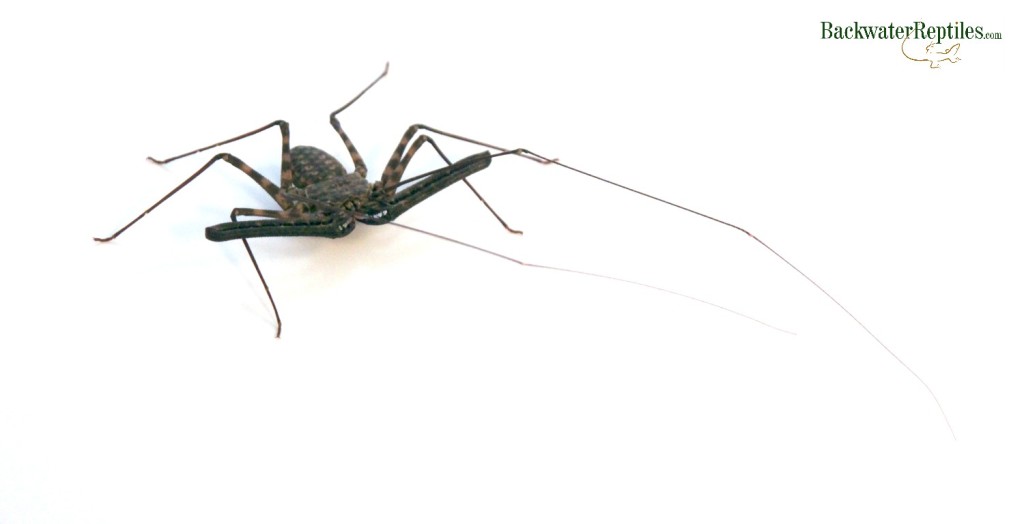How Often Do You Feed a Tailless Whip Scorpions
Wondering how to care for a Whip spider? Well, you've come to the right place. Whip spiders are arachnids also known by the name tailless whip scorpions. They belong to an order of arthropods named Amblypygi and are not to be confused with whip scorpions and vinegaroons, which are similar invertebrates that belong to a different order.
Although these arachnids are commonly known as tailless whip scorpions, they do earn their name, as they are indeed tailless. In fact, the word Amblypygi actually means "blunt rump" and refers to the fact that these animals don't actually possess stinging scorpion tails or silk saks.
They do, however, have pinching pedipalps (AKA pinchers) that can grab your fingers if the scorpion feels threatened. But they aren't venomous, nor are they usually aggressive, so they aren't considered dangerous pets.

Tailless whip scorpions are flat, wide invertebrates with eight legs. Only six of these legs are actually used for walking and the scorpion has a somewhat sideways gait similar to that of a crab. The front appendages are modified into long, thin segmented feelers, which the scorpion uses to orient itself and find prey. These feelers, which just happen to resemble whips, are also what gives these arachnids their common name.
When their legs are not stretched out, most whip spiders will average around two to three inches in length. However, it has been reported that these scorpions can stretch out to make their leg span as long as twenty three inches.
Tailless Whip Spider Care
When it comes to feeding, tailless whip scorpions are sit and wait predators. They will patiently wait and feel around with their long "antennae" until they sense that prey is nearby. Once the scorpion detects that prey is close enough, it will pounce and grab the prey using its pinchers and immediately begin chewing.
In the wild, whip spiders are insectivores primarily. In captivity, we give ours meals of crickets, roaches, and occasional wax worms. Sometimes, if your whip spider isn't too shy, you can even get it to accept an insect from tongs.

Like all arachnids, whip spiders molt as they grow. However, unlike most spiders and scorpions, they require a place to hang from while molting. Most arachnids will molt on the ground, but whip spiders need a vertical space to hang from while they wriggle out of their old exoskeleton. Therefore, it is absolutely imperative that owners provide a surface that the scorpion can cling to in order to perform this behavior.
Directly following a molt, your whip spider will be a white or green color and will be far more vulnerable. This means that prey items such as crickets or roaches that can bite your whip spider need to be removed immediately from the cage if they are not eaten.
Believe it or not, prey can actually injure the whip spider while it is green or white. But not to worry – after a few days, your whip spider's new exoskeleton will harden and you can resume feeding as normal.
Whip spiders are fairly active arachnids, so we recommend a decent sized enclosure. A ten gallon tank should suffice for a single scorpion, but if you add additional house mates, a larger home will obviously be required.
As previously mentioned when molting was discussed, be sure to have multiple angled surface with various textures that your scorpion can cling to and hang from while molting. And as far as substrate is concerned, anything that holds moisture will do just fine. We recommend coconut fiber, peat moss, or organic potting soil.
Be sure to maintain high humidity levels in your whip spider's enclosure. These are animals that are naturally found in wet caves with naturally collecting water. They need humidity to thrive and go through proper molting.
A good way to maintain humidity is to mist your whip scorpion's enclosure. This is also helpful because the scorpions won't drink from a standing water dish, but they will drink water that has naturally collected on cage décor.

Caring for Tailless Whip Spiders – Conclusion
We think that whip spiders make excellent pets and are simple to care for, especially for people who want an arachnid but don't want to be bitten by a spider or stung by a scorpion.
whartontheaunnowly76.blogspot.com
Source: https://backwaterreptilesblog.com/care-whip-spider-amblypygi-sp/
0 Response to "How Often Do You Feed a Tailless Whip Scorpions"
Post a Comment